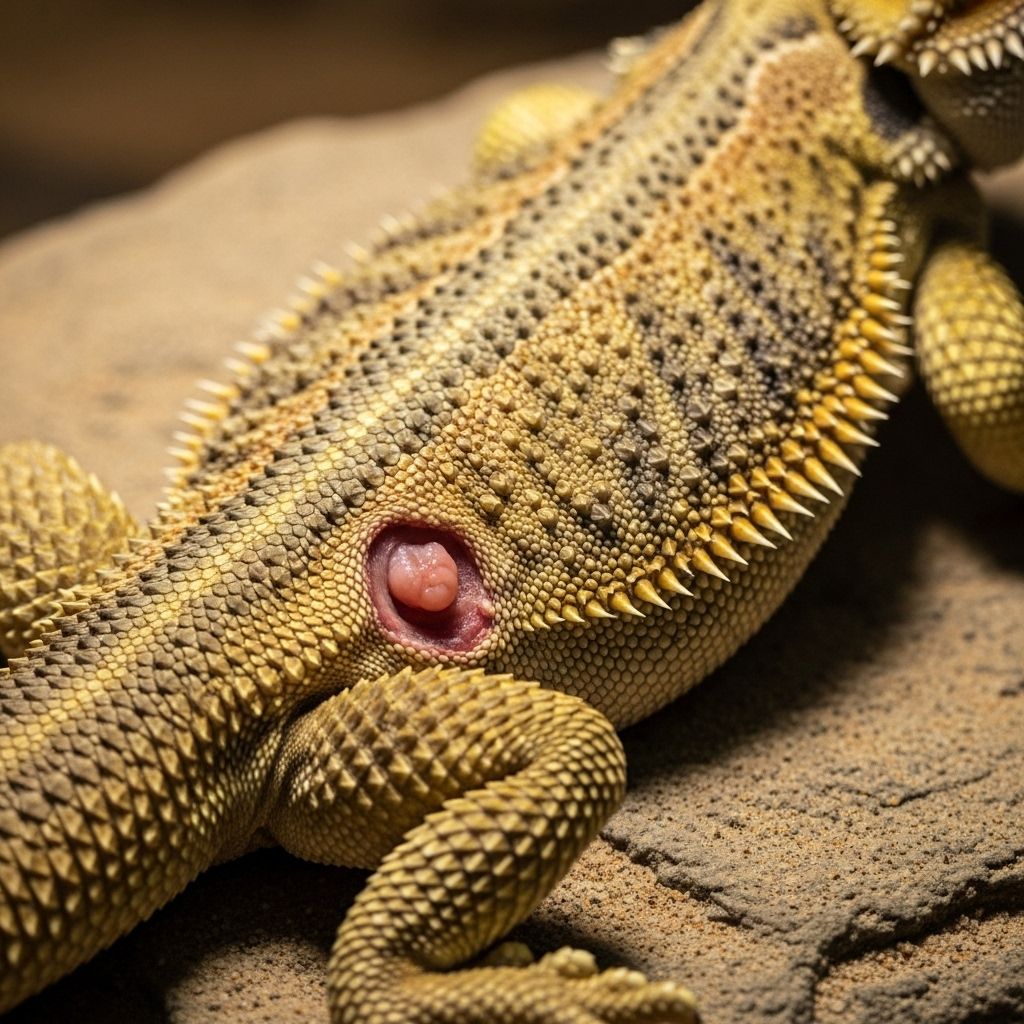Bearded Dragon Prolapse: Causes, Symptoms, and Treatment
Timely first aid and proper husbandry boost recovery for reptiles with cloacal problems.

Bearded Dragon Prolapse: What Owners Need to Know
Bearded dragons are charismatic and often hardy pet reptiles, but they are susceptible to certain health problems—one of the most alarming and potentially life-threatening being prolapse. This condition, also known as cloacal prolapse, occurs when an internal organ extends out of the cloaca (the vent), leaving sensitive tissue exposed and vulnerable. Rapid recognition and intervention are essential for the welfare of your bearded dragon.
What is Prolapse in Bearded Dragons?
Prolapse occurs when an internal organ, such as the intestines, hemipenes (in males), or oviducts (in females), is forced outside of the body through the cloaca. The protruding tissue typically appears as moist, pink or red, finger-like, or tubular masses sticking out from the vent. Prolapse is a symptom—not a disease itself—indicating a significant underlying problem.
Commonly Affected Organs
- Intestines – often linked to constipation, impaction, or gastrointestinal illness.
- Hemipenes – the reproductive organs in males, may prolapse after mating activity or sexual stimulation.
- Oviducts – in females, may be forced out due to egg laying or reproductive complications.
Visual Signs of Prolapse
- Pink, red, or purple tubular tissue protruding from the cloaca (vent).
- Swelling, drying, bruising, or discoloration of the exposed tissue.
- Lethargy, straining, or attempts to defecate without success.
Symptoms of Bearded Dragon Prolapse
- Visible tissue emerging from the cloaca, moist or dry in appearance.
- Changes in color of the tissue—healthy tissue is pink; purple, blue, or black indicates necrosis or drying.
- Lethargy and distress.
- Lack of appetite or refusal to eat.
- Excessive straining to defecate or lay eggs.
- Dragging hindquarters or rubbing vent against objects.
What Causes Cloacal Prolapse in Bearded Dragons?
The underlying causes of cloacal prolapse can be varied, multifactorial, and sometimes complex. Identifying and treating the root issue is crucial to prevent recurrence.
| Cause | Details & Examples |
|---|---|
| Dehydration | Leads to dry stool, straining to defecate, and tissue fragility. |
| Impaction | Obstruction in the bowel (from substrate, large food, or foreign bodies) causes extreme straining. |
| Egg Binding (Dystocia) | Females unable to pass eggs may strain excessively, forcing tissue out. |
| Mating Trauma | Particularly in males, resulting in hemipenal prolapse after mating activities. |
| Parasitic or Bacterial Infections | Gastrointestinal parasites or infections may cause inflammation, diarrhea, and straining. |
| Improper Husbandry | Poor diet (low calcium, excessive protein), suboptimal temperatures, or unsanitary conditions leading to stress and illness. |
| Other Illness | Bladder stones, metabolic bone disease (MBD), or generalized weakness of cloacal muscles. |
Types of Prolapse in Bearded Dragons
Bearded dragons may experience prolapse in any of the following organs:
- Gastrointestinal Tract Prolapse: Intestinal tissue emerges through the cloaca due to straining or impaction.
- Reproductive Tract Prolapse: Oviduct (females) or hemipenes (males) pushed out, often after reproductive activities or complications.
- Bladder Prolapse: Less common, but may occur due to urinary stones or severe infection.
Immediate Steps: What to Do If You Suspect Prolapse
Prolapse requires emergency veterinary care. If you notice any tissue protruding from your bearded dragon’s vent, act rapidly:
- Keep the Tissue Moist
- Gently rinse the prolapsed organ with sterile saline or clean, lukewarm water to remove debris and prevent drying.
- Do not use soaps, hydrogen peroxide, or strong chemicals.
- Apply a water-based lubricant (like KY Jelly or Vaseline) to keep the tissue moist until a vet visit.
- Minimize Contamination
- Place the dragon on clean, disinfected paper towels—avoid sand or loose substrate.
- Keep your pet in a safe, warm, and quiet environment for transport.
- Do Not Attempt to Force Tissue Back In
- Without vet assessment, do not push the tissue back yourself as you may cause further injury or infection.
- Seek Emergency Veterinary Care
- Time is critical—delayed action may result in tissue death and necrosis, which can be fatal.
Optional First Aid at Home (If Vet Visit is Delayed)
While veterinary care is vital, you may take these steps before transport:
- Soak in Sugar Water Solution: Prepare a bath of warm water with dissolved sugar to help reduce swelling of the prolapsed tissue (typically 1-2 tablespoons of sugar per cup of water). Let the dragon soak for 10–15 minutes.
- Apply Sugar Paste: A small amount of sugar mixed with water can be gently applied to the protruding tissue to draw out excess fluids and decrease swelling, making reduction easier for the vet.
- Remove All Loose Substrate: Ensure that no sand, mulch, or other particulate contaminants come into contact with the exposed tissue.
Veterinary Diagnosis and Treatment Process
Veterinary Examination
Upon arrival at the vet, your bearded dragon will undergo a thorough physical exam. The vet will assess the viability of the tissue (distinguishing healthy pink from necrotic dark tissue), and determine the underlying cause through history, blood work, imaging, or fecal analysis.
Treatment Procedures
- Tissue Assessment and Reduction: The vet gently cleans, lubricates, and may soak the tissue in a hypertonic solution like sugar water to reduce swelling before carefully repositioning the organ.
- Suturing (Stay Sutures): Temporary stitches may be placed across the vent to hold tissues in position and help prevent recurrence. These are removed when the prolapsed organ has healed.
- Surgical Intervention: If tissue is necrotic (dead), surgical removal of the non-viable section is necessary.
- Treatment of Underlying Condition: This may include fluids for dehydration, laxatives or enemas for impaction, antibiotics for infection, calcium supplementation, or hormonal manipulation for reproductive issues.
Prognosis: What to Expect After Prolapse Treatment
- Favorable Outcome: If addressed quickly, most dragons recover well after a prolapse is corrected and the underlying cause is managed.
- Poor Outcome: If treatment is delayed, exposed tissue may become infected, necrotic, or require surgical removal, significantly decreasing the chance of survival.
- Possible Recurrence: If the underlying issue remains, prolapse can reoccur. Vigilant husbandry and follow-up care are crucial.
Preventing Prolapse in Bearded Dragons
- Maintain Proper Hydration: Ensure a constant supply of fresh water and offer water-dense foods.
- Proper Diet and Calcium: Feed a balanced diet with appropriate greens, vegetables, protein, and calcium supplementation to avoid constipation and egg-binding.
- Optimal Husbandry: Maintain proper basking temperatures, humidity, and UVB lighting.
- Avoid Loose Substrate: Use paper towels, reptile carpet, or tile—avoid sand and particulate bedding that can cause impaction.
- Regular Vet Visits: Annual or semi-annual check-ups, including fecal parasite screening and health exams, help catch issues early.
- Careful Monitoring of Reproductive Females: Ensure adequate nutrition, calcium, and proper nesting sites for egg-laying females to prevent dystocia.
Frequently Asked Questions (FAQs)
Q: What does a prolapse look like in a bearded dragon?
A: A prolapse appears as a finger-like, pink to red tube or mass sticking out of the bearded dragon’s vent (cloaca). The tissue may become dark or dry if not kept moist.
Q: Can you treat a prolapse at home?
A: Home care options such as keeping tissue moist and soaking in sugar water may help reduce swelling temporarily, but veterinary care is absolutely required for proper reduction, assessment, and to prevent further harm.
Q: How urgent is a prolapse?
A: Prolapse is a true emergency. Delaying veterinary care risks necrosis (tissue death), infection, and potentially fatal complications.
Q: What are the most common causes of bearded dragon prolapse?
A: Impaction (blockage), dehydration, mating trauma, egg binding, and parasitic infections are among the most frequent causes.
Q: Will a prolapse come back?
A: Recurrence is possible if the underlying problem (e.g., impaction, reproductive disorder, poor husbandry) is not corrected. Preventive care is important to minimize the risk of repeat prolapse.
Final Thoughts
Bearded dragon prolapse is an alarming condition demanding urgent intervention. Early detection and emergency steps at home (such as keeping tissue moist and removing debris) can protect your pet until you reach a reptile-experienced veterinarian. Long-term success hinges on identifying the underlying cause and optimizing husbandry. With attentive care, many bearded dragons recover from prolapse and return to good health.
References
- https://reptifiles.com/bearded-dragon-care/bearded-dragon-illnesses-health/prolapse/
- https://www.youtube.com/watch?v=ArhEXkDCpe0
- https://wpvet.com/reptile-rounds/cloacal-prolapse/
- https://assets.ctfassets.net/4dmg3l1sxd6g/6RycFF2VB0azyqyM13y25F/b3783c862ff68cb2977d36d1d489280a/beardeddragon-4588-article.pdf
- https://www.veterinary-practice.com/article/cloacal-prolapses-in-reptiles
Read full bio of medha deb












